Top Crypto Trading Platforms in 2025




Big news: We’re cranking up the heat on AI-driven crypto analytics with the launch of the Token Metrics API and our official SDK (Software Development Kit). This isn’t just an upgrade – it's a quantum leap, giving traders, hedge funds, developers, and institutions direct access to cutting-edge market intelligence, trading signals, and predictive analytics.
Crypto markets move fast, and having real-time, AI-powered insights can be the difference between catching the next big trend or getting left behind. Until now, traders and quants have been wrestling with scattered data, delayed reporting, and a lack of truly predictive analytics. Not anymore.
The Token Metrics API delivers 32+ high-performance endpoints packed with powerful AI-driven insights right into your lap, including:
Getting started with the Token Metrics API is simple:
At Token Metrics, we believe data should be decentralized, predictive, and actionable.
The Token Metrics API & SDK bring next-gen AI-powered crypto intelligence to anyone looking to trade smarter, build better, and stay ahead of the curve. With our official SDK, developers can plug these insights into their own trading bots, dashboards, and research tools – no need to reinvent the wheel.
Cryptocurrency investing intimidates many potential investors. The technical jargon, overwhelming number of tokens, security concerns, and stories of people losing fortunes create paralysis. You know crypto represents an opportunity, but where do you even begin?
Token Metrics AI Indices eliminate these barriers by providing a simple, secure pathway into cryptocurrency investing. Whether you've never bought crypto before or you're transitioning from traditional investments, this comprehensive beginner's guide walks you through everything needed to start investing successfully in just 30 minutes.
No technical expertise required. No complicated wallet setup. No endless research into thousands of tokens. Just straightforward steps that get you invested intelligently and positioned for long-term wealth creation.
Before diving into the how-to, let's establish a simple understanding of what you're investing in.
Think of crypto indices like a basket containing multiple cryptocurrencies. Instead of buying Bitcoin or Ethereum individually, you buy a pre-made collection of several carefully selected digital assets. This is similar to how traditional stock index funds like the S&P 500 contain hundreds of companies rather than forcing you to pick individual stocks.
Token Metrics creates these baskets using artificial intelligence that analyzes thousands of cryptocurrencies and selects the best ones based on comprehensive data. The AI acts like a team of expert analysts working 24/7, constantly monitoring market conditions and adjusting your portfolio to maximize returns while managing risk.
When you invest in a Token Metrics index, you're essentially hiring sophisticated AI technology to build and manage your crypto portfolio professionally. You get instant diversification across multiple tokens, automatic rebalancing when market conditions change, protection from common investing mistakes, and access to opportunities you'd never find independently.
The beauty of this approach is simplicity. You don't need to understand blockchain technology, read complicated whitepapers, or analyze trading charts. The AI handles complexity while you focus on your life and watch your investment grow.
New investors often make the mistake of buying individual cryptocurrencies based on social media hype, friend recommendations, or price momentum. This approach leads to several problems that indices elegantly solve.
• Individual token selection requires expertise most beginners lack. How do you evaluate whether a cryptocurrency's technology is legitimate or vaporware? How do you determine if tokenomics are sustainable? How do you identify scams before they steal your money? Without experience, these questions prove nearly impossible to answer correctly.
• Concentration risk destroys portfolios quickly. If you invest everything in three tokens and one fails catastrophically, you lose a third of your capital immediately. Indices spread risk across 10-30 carefully vetted assets, ensuring single failures don't devastate your portfolio.
• Emotional decision-making causes most investment losses. Fear drives panic selling during downturns. Greed drives buying at market tops. FOMO drives chasing pumps into overvalued assets. AI indices eliminate emotion entirely, maintaining discipline when human investors make terrible decisions.
• Time requirements prove unsustainable. Successfully managing individual crypto positions requires hours daily monitoring markets, reading news, analyzing charts, and executing trades. Most people with jobs and families can't sustain this commitment. Indices require maybe 30 minutes quarterly.
For beginners, indices provide the perfect entry point—immediate diversification, professional management, emotion-free investing, and minimal time commitment. You can start small, learn gradually, and scale up as you become comfortable.
Ready to begin? Follow this simple roadmap to go from complete beginner to invested in under 30 minutes.
Minutes 1-5: Create Your Token Metrics Account
Visit the Token Metrics website and click the sign-up button. You'll need to provide basic information including email address, create a secure password, and verify your email through the confirmation link sent to your inbox.
Token Metrics offers a 7-day free trial, allowing you to explore the platform thoroughly before committing financially. Take advantage of this trial to familiarize yourself with available indices, review performance data, and understand the interface.
During signup, you'll choose a subscription tier. For beginners, start with the basic tier that provides access to all indices and essential features. You can upgrade later if you want additional tools like advanced analytics or trading signals.
Minutes 6-15: Explore Available Indices and Choose Your Strategy
Once logged in, navigate to the Indices section. You'll see several different index options, each designed for specific investment strategies and risk profiles. Here's how to choose:
• Conservative Investor Grade Index: If you're risk-averse, older, or investing money you can't afford to lose, start here. This index focuses on established cryptocurrencies with strong fundamentals—primarily Bitcoin, Ethereum, and select large-cap altcoins. Returns are more moderate but volatility is lower.
• Balanced Growth Index: If you're comfortable with moderate risk and seeking steady growth, this balanced approach combines major cryptocurrencies with promising mid-cap projects. It offers stronger growth potential than conservative indices while maintaining reasonable risk levels.
• Aggressive Growth Index: If you're young, risk-tolerant, and seeking maximum returns, this index targets smaller-cap tokens with explosive potential. Volatility is higher but so are potential returns. Only choose this if you can stomach significant price swings.
• Sector-Specific Indices: Token Metrics offers indices focused on specific crypto sectors like DeFi, Layer-1 blockchains, AI tokens, or memecoins. Choose these if you believe strongly in a particular sector's growth potential.
For most beginners, starting with the Balanced Growth Index makes sense. It provides diversification, reasonable growth potential, and manageable volatility. You can always adjust later as you learn more.
Minutes 16-20: Determine Your Investment Amount
How much should you invest in crypto indices? This critical decision depends on your financial situation, but follow these general guidelines.
• Never invest money you need for living expenses. Crypto remains volatile. Only invest money you won't need for at least 3-5 years and that you could lose entirely without affecting your lifestyle.
• Start small while learning. If you're completely new to crypto, consider investing just $500-1,000 initially. Get comfortable with the process, experience some market volatility, and understand how indices work before committing larger amounts.
• Follow the 5-20% rule. Financial advisors typically recommend allocating 5-20% of your total investment portfolio to cryptocurrency depending on age and risk tolerance. If you have $50,000 in traditional investments, consider $2,500-10,000 in crypto.
• Use dollar-cost averaging. Rather than investing your entire amount immediately, spread purchases over 3-6 months. If you plan to invest $6,000, invest $1,000 monthly. This reduces timing risk and smooths out entry prices.
Write down your investment amount now so you don't invest emotionally based on market conditions. Stick to your predetermined plan regardless of whether markets are surging or crashing.
Minutes 21-25: Set Up Your Exchange Account and Funding
To invest in Token Metrics indices, you need to purchase the recommended cryptocurrencies through a cryptocurrency exchange. Major exchanges include Coinbase, Kraken, Binance.US, or Gemini.
• Choose one exchange and create an account. You'll need to provide identification for regulatory compliance—typically a driver's license or passport. This verification process usually takes a few hours to a few days, so you might need to pause here and return once approved.
• Once verified, connect a funding source. Most beginners use bank transfers, though credit cards and debit cards work too (often with higher fees). Transfer funds from your bank account to your exchange account. Bank transfers typically take 1-3 business days but have lower fees than card payments.
• For security, enable two-factor authentication (2FA) on your exchange account immediately. This adds an extra security layer requiring a code from your phone when logging in, protecting against unauthorized access.
Minutes 26-30: Make Your First Index-Aligned Purchases
Now comes the exciting part—your first crypto investments. Token Metrics indices provide specific recommendations about which tokens to buy and in what proportions.
Review your chosen index's current composition. It might show something like: 40% Bitcoin, 25% Ethereum, 15% Solana, 10% Avalanche, 10% Polkadot. These percentages tell you how to allocate your investment.
If investing $1,000, you'd buy approximately $400 in Bitcoin, $250 in Ethereum, $150 in Solana, $100 in Avalanche, and $100 in Polkadot. Round to reasonable amounts given minimum purchase requirements.
On your exchange, navigate to each cryptocurrency and execute market buy orders. A market order purchases at current market price immediately. For beginners, market orders are simplest—don't worry about limit orders or advanced trading features initially.
After purchasing, you can either leave assets on the exchange (simplest for beginners with small amounts) or transfer to a personal wallet (more secure for larger holdings). Initially, leaving assets on a reputable exchange is fine. Learn about wallet security as your investment grows.
Congratulations! You're now invested in crypto indices. The entire process took under 30 minutes.
After your initial investment, understanding ongoing management helps you stay invested successfully.
Token Metrics indices rebalance regularly as market conditions change. You'll receive notifications when adjustments are recommended. These typically occur weekly, bi-weekly, or monthly. Follow the recommendations by making small adjustments—usually just a few minutes to execute.
Check your portfolio monthly rather than daily. Cryptocurrency volatility means dramatic day-to-day swings. Monthly reviews allow tracking overall trajectory without getting caught up in noise. Token Metrics provides performance tracking tools showing returns over various periods and comparing to benchmarks.
Occasionally rebalance your overall portfolio allocation. If crypto has grown from 10% to 25% of your total investments, consider taking profits to rebalance back to your target. This ensures you don't become overexposed during market euphoria.
New investors often have the same questions and concerns. Here are straightforward answers.
"Is crypto investing safe?"
Cryptocurrency carries risk like all investments. However, indices are far safer than buying random tokens. Token Metrics' AI vetting filters out scams, diversification reduces risk, and professional management protects against emotional mistakes.
"What if I lose everything?"
This is why you only invest money you can afford to lose. Crypto indices are diversified across multiple assets, making total loss extremely unlikely. Individual tokens can fail, but portfolios of 10-30 carefully selected tokens provide resilience.
"How much can I make?"
Token Metrics indices have historically delivered returns significantly exceeding Bitcoin and Ethereum. Conservative indices might return 100-200% annually during bull markets. Aggressive indices could deliver 300-500%+. Bear markets may see negative returns—long-term holding is essential.
"What about taxes?"
Cryptocurrency transactions trigger capital gains taxes in most jurisdictions. Keep records of all transactions. Token Metrics provides transaction tracking to simplify tax preparation. Consult a tax professional for personalized guidance.
"Do I need a special wallet?"
For beginners with smaller amounts, keeping crypto on a reputable exchange is acceptable. As holdings grow beyond $10,000, consider a hardware wallet for additional security.
"Can I start with just $100?"
Yes! While larger amounts generate more absolute returns, you can start with any amount. Use small initial investments to learn and build confidence.
You've made your first investment. Here's your plan for the next 30 days to build upon this foundation.
• Days 1-7: Leave your investment alone. Resist checking prices constantly. Use this week to explore Token Metrics' educational resources and learn about the cryptocurrencies in your index.
• Days 8-14: Conduct your first performance review. Don't react emotionally to gains or losses. Review any rebalancing recommendations and execute them if suggested.
• Days 15-21: Evaluate whether your initial allocation feels appropriate. If you chose dollar-cost averaging, make your second purchase following your predetermined schedule.
• Days 22-30: Reflect on your first month. Did you stay calm during volatility? Are you confident in your strategy? Decide whether to continue your current approach or make adjustments.
After 30 days, continue monthly reviews, execute recommended rebalancing, and stick to your dollar-cost averaging schedule. Successful investing is about consistency and discipline, not constant activity.
Cryptocurrency investing doesn't require technical expertise, complicated processes, or endless time commitment. Token Metrics AI Indices make professional-grade crypto investing accessible to anyone willing to follow a simple, proven system.
You've learned what indices are, why they're perfect for beginners, and exactly how to get started in 30 minutes. You understand ongoing management, have answers to common concerns, and possess a 30-day action plan for success.
The only thing remaining is action. Every day you delay is a day you're not participating in one of the most significant wealth creation opportunities of our generation. Markets don't wait for perfect timing—they reward those who begin with imperfect action.
Your 30-minute journey to crypto investing starts with a single click. Sign up for Token Metrics' 7-day free trial today, explore the indices, and make your first investment following this guide. Your future self will thank you for taking action now rather than watching from the sidelines as others build life-changing wealth.
The tools are available. The guidance is clear. The opportunity is now. Begin your Token Metrics journey today.
Crypto is transitioning into a broadly bullish regime into 2026 as liquidity improves and adoption deepens.
Regulatory clarity is reshaping the classic four-year cycle, flows can arrive earlier and persist longer as institutions gain confidence.
Access and infrastructure continue to mature with ETFs, qualified custody, and faster L2 scaling that reduce frictions for new capital.
Real‑world integrations expand the surface area for crypto utility, which supports sustained participation across market phases.
This backdrop frames our scenario work for DOGE. The bands below reflect different total market sizes and DOGE's share dynamics.
Read the TLDR first, then dive into grades, catalysts, and risks.

How to read it: Each band blends cycle analogues and market-cap share math with TA guardrails. Base assumes steady adoption and neutral or positive macro. Moon layers in a liquidity boom. Bear assumes muted flows and tighter liquidity.
TM Agent baseline: Token Metrics lead metric, TM Grade, is 22.65 (Sell), and the trading signal is bearish, indicating short-term downward momentum. Price context: $DOGE is trading around $0.193, rank #9, down about 3.1% in 24 hours and roughly 16% over 30 days. Implication: upside likely requires a broader risk-on environment and renewed retail or celebrity-driven interest.
Live details: Dogecoin Token Details → https://app.tokenmetrics.com/en/dogecoin
• Scenario driven, outcomes hinge on total crypto market cap, higher liquidity and adoption lift the bands.
• Technology: Technology Grade 54.58% (Activity 36%, Repository 72%, Collaboration 61%, Security N/A, DeFi Scanner N/A).
• TM Agent gist: cautious long‑term stance until grades and momentum improve.
• Education only, not financial advice.
8T: 
16T: 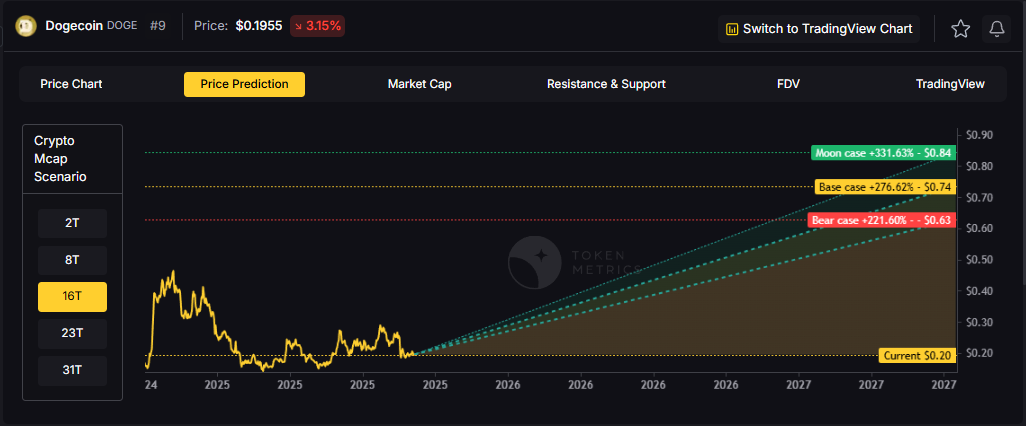
23T: 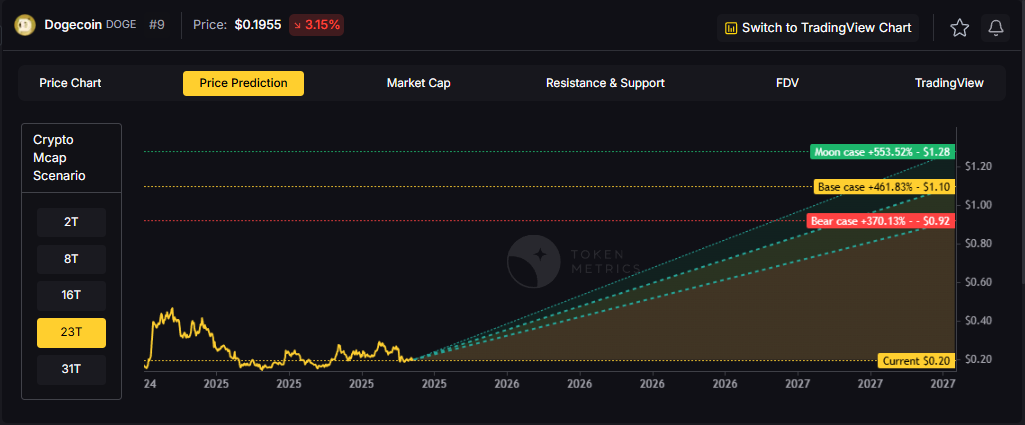
31T: 
Diversification matters. Dogecoin is compelling, yet concentrated bets can be volatile. Token Metrics Indices hold DOGE alongside the top one hundred tokens for broad exposure to leaders and emerging winners.
Our backtests indicate that owning the full market with diversified indices has historically outperformed both the total market and Bitcoin in many regimes due to diversification and rotation.
Dogecoin is a peer-to-peer cryptocurrency that began as a meme but has evolved into a widely recognized digital asset used for tipping, payments, and community-driven initiatives. It runs on its own blockchain with inflationary supply mechanics. The token’s liquidity and brand awareness create periodic speculative cycles, especially during broad risk-on phases.
Technology Snapshot from Token Metrics
Technology Grade: 54.58% (Activity 36%, Repository 72%, Collaboration 61%, Security N/A, DeFi Scanner N/A).
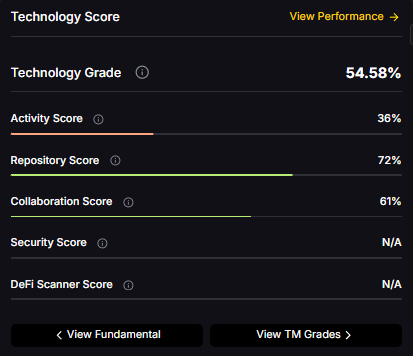
Catalysts That Skew Bullish
• Institutional and retail access expands with ETFs, listings, and integrations.
• Macro tailwinds from lower real rates and improving liquidity.
• Product or roadmap milestones such as upgrades, scaling, or partnerships.
Risks That Skew Bearish
• Macro risk-off from tightening or liquidity shocks.
• Regulatory actions or infrastructure outages.
• Concentration or validator economics and competitive displacement.
Special Offer — Token Metrics Advanced Plan with 20% Off
Unlock platform-wide intelligence on every major crypto asset. Use code ADVANCED20 at checkout for twenty percent off.
• AI powered ratings on thousands of tokens for traders and investors.
• Interactive TM AI Agent to ask any crypto question.
• Indices explorer to surface promising tokens and diversified baskets.
• Signal dashboards, backtests, and historical performance views.
• Watchlists, alerts, and portfolio tools to track what matters.
• Early feature access and enhanced research coverage.
Can DOGE reach $1.00?
Yes, multiple tiers imply levels above $1.00 by the 2027 horizon, including the 23T Base and all 31T scenarios. Not financial advice.
Is DOGE a good long-term investment?
Outcome depends on adoption, liquidity regime, competition, and supply dynamics. Diversify and size positions responsibly.

• Track live grades and signals: Token Details
• Join Indices Early Access
• Want exposure Buy DOGE on MEXC
Disclosure
Educational purposes only, not financial advice. Crypto is volatile, do your own research and manage risk.
The crypto market is shifting toward a broadly bullish regime into 2026 as liquidity improves and risk appetite normalizes.
Regulatory clarity across major regions is reshaping the classic four-year cycle, flows can arrive earlier and persist longer.
Institutional access keeps expanding through ETFs and qualified custody, while L2 scaling and real-world integrations broaden utility.
Infrastructure maturity lowers frictions for capital, which supports deeper order books and more persistent participation.
This backdrop frames our scenario work for TRX. The bands below map potential outcomes to different total crypto market sizes.
Use the table as a quick benchmark, then layer in live grades and signals for timing.
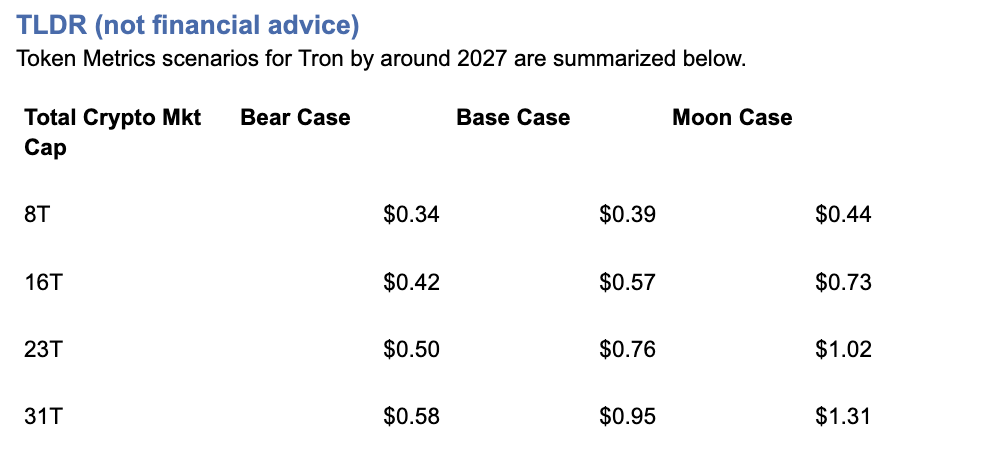
Current price: $0.2971.
How to read it: Each band blends cycle analogues and market-cap share math with TA guardrails. Base assumes steady adoption and neutral or positive macro. Moon layers in a liquidity boom. Bear assumes muted flows and tighter liquidity.
TM Agent baseline: Token Metrics TM Grade for $TRX is 19.06, which translates to a Strong Sell, and the trading signal is bearish, indicating short-term downward momentum. Price context: $TRX is trading around $0.297, market cap rank #10, and is down about 11% over 30 days while up about 80% year-over-year, it has returned roughly 963% since the last trading signal flip.
Live details: Tron Token Details → https://app.tokenmetrics.com/en/tron
Buy TRX: https://www.mexc.com/acquisition/custom-sign-up?shareCode=mexc-2djd4
• Scenario driven, outcomes hinge on total crypto market cap, higher liquidity and adoption lift the bands.
• TM Agent gist: bearish near term, upside depends on a sustained risk-on regime and improvements in TM Grade and the trading signal.
• Education only, not financial advice.
8T: 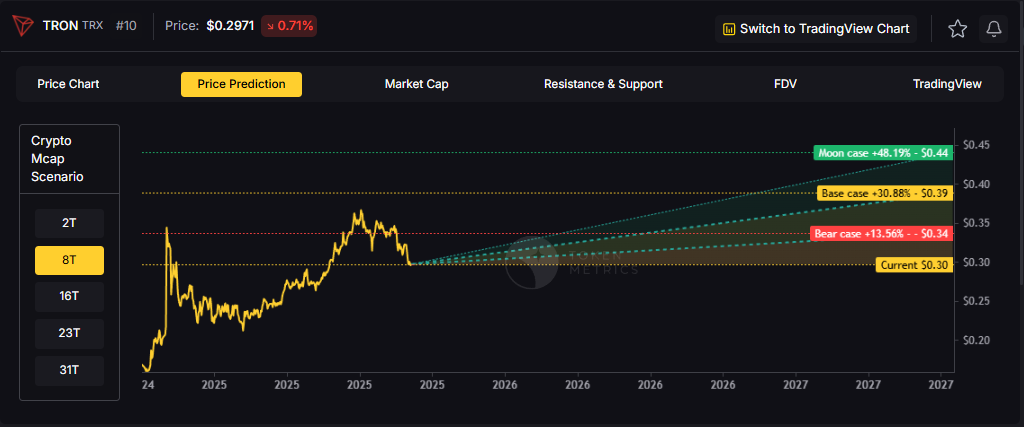
16T: 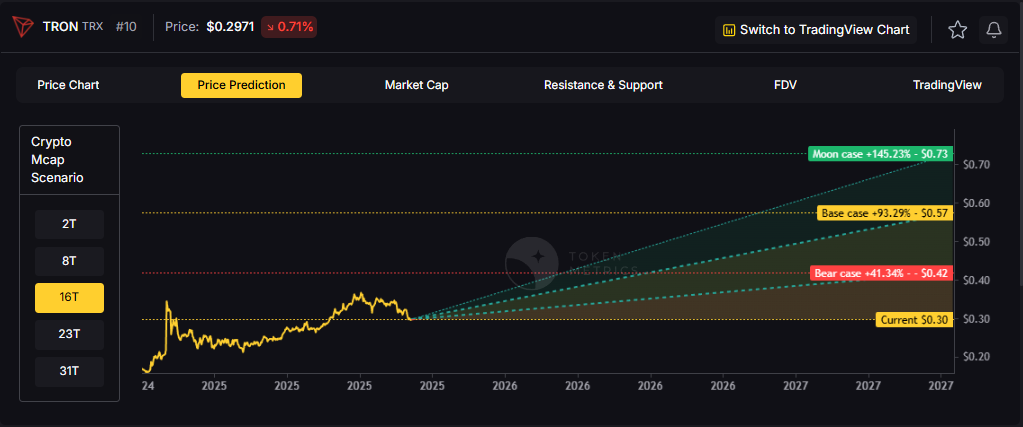
23T: 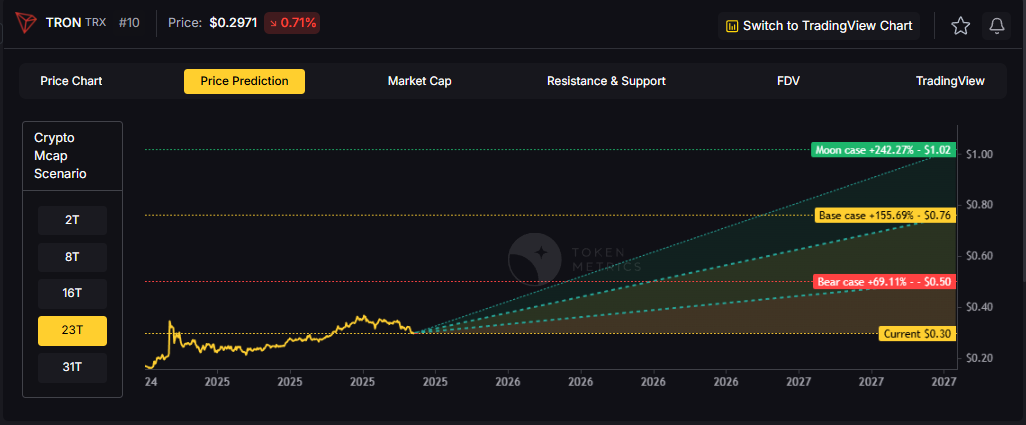
Diversification matters. Tron is compelling, yet concentrated bets can be volatile. Token Metrics Indices hold TRX alongside the top one hundred tokens for broad exposure to leaders and emerging winners.
Our backtests indicate that owning the full market with diversified indices has historically outperformed both the total market and Bitcoin in many regimes due to diversification and rotation.
Get early access: https://docs.google.com/forms/d/1AnJr8hn51ita6654sRGiiW1K6sE10F1JX-plqTUssXk/preview
If your editor supports embeds, place a form embed here. Otherwise, include the link above as a button labeled Join Indices Early Access.
Tron is a smart-contract blockchain focused on low-cost, high-throughput transactions and cross-border settlement.
The network supports token issuance and a broad set of dApps, with an emphasis on stablecoin transfer volume and payments.
TRX is the native asset that powers fees and staking for validators and delegators within the network.
Developers and enterprises use the chain for predictable costs and fast finality, which supports consumer-facing use cases.
Catalysts That Skew Bullish
• Institutional and retail access expands with ETFs, listings, and integrations.
• Macro tailwinds from lower real rates and improving liquidity.
• Product or roadmap milestones such as upgrades, scaling, or partnerships.
Risks That Skew Bearish
• Macro risk-off from tightening or liquidity shocks.
• Regulatory actions or infrastructure outages.
• Concentration or validator economics and competitive displacement.
Unlock platform-wide intelligence on every major crypto asset. Use code ADVANCED20 at checkout for twenty percent off.
• AI powered ratings on thousands of tokens for traders and investors.
• Interactive TM AI Agent to ask any crypto question.
• Indices explorer to surface promising tokens and diversified baskets.
• Signal dashboards, backtests, and historical performance views.
• Watchlists, alerts, and portfolio tools to track what matters.
• Early feature access and enhanced research coverage.
Start with Advanced today → https://www.tokenmetrics.com/token-metrics-pricing
Can TRX reach $1?
Yes, the 23T moon case shows $1.02 and the 31T moon case shows $1.31, which imply a path to $1 in higher-liquidity regimes. Not financial advice.
Is TRX a good long-term investment
Outcome depends on adoption, liquidity regime, competition, and supply dynamics. Diversify and size positions responsibly.
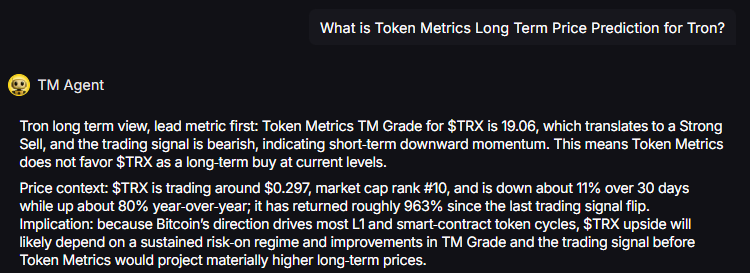
Track live grades and signals: Token Details → https://app.tokenmetrics.com/en/tron
Join Indices Early Access: https://docs.google.com/forms/d/1AnJr8hn51ita6654sRGiiW1K6sE10F1JX-plqTUssXk/preview
Want exposure Buy TRX on MEXC → https://www.mexc.com/acquisition/custom-sign-up?shareCode=mexc-2djd4
Disclosure
Educational purposes only, not financial advice. Crypto is volatile, do your own research and manage risk.
